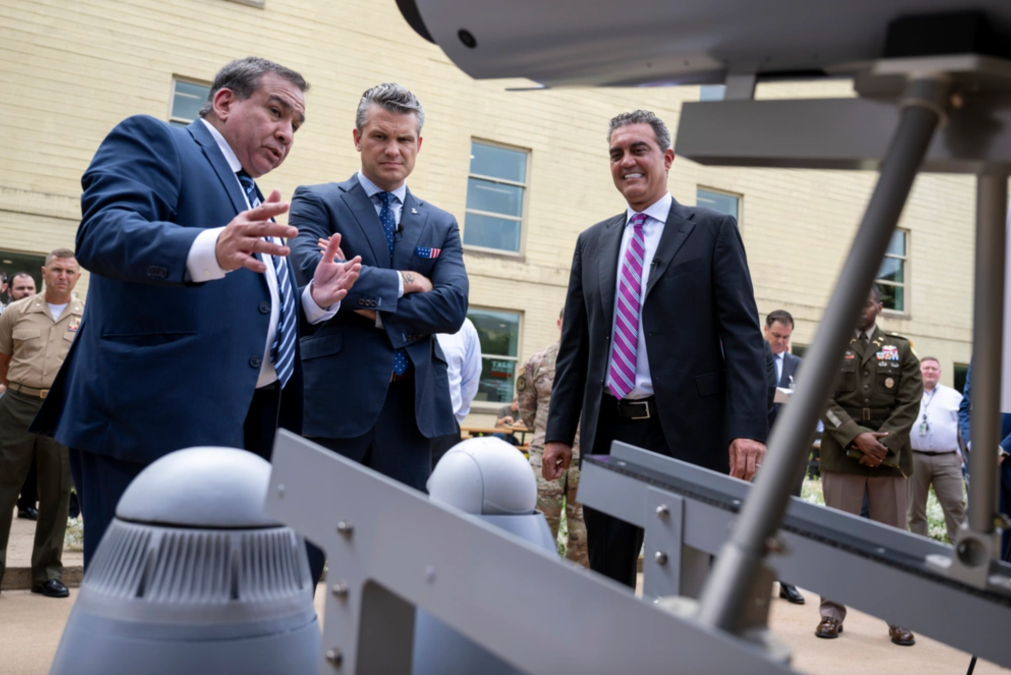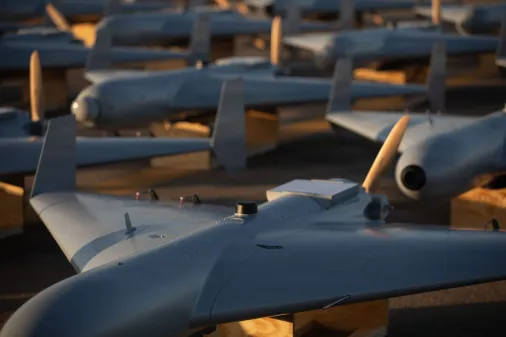Pentagon seeks to surge its multi-domain drone arsenal

As a leading player in the Trump administration’s new high-priority plan to “unleash American drone dominance,” the Pentagon is moving to reduce bureaucratic barriers and speedily expand the quantities and types of U.S.-approved autonomous systems military personnel can access for operations across warfighting domains, senior officials told a small group of reporters at the Pentagon on Wednesday.
“We will speed up the timeline of rapid innovation. We have to, on behalf of our warfighters, on behalf of the threats that we face around the globe, on behalf of the changing face of warfare,” Secretary of Defense Pete Hegseth said.
During the “Multi-Domain Autonomous Solutions” event in the Pentagon courtyard, Hegseth and other Defense Department leaders shared new details about their near-term plans to quickly and drastically enhance the military’s drone arsenal, and deepen partnerships with producers across the sprawling American industrial base as they confront a range of contemporary policy and supply chain challenges.
Eighteen autonomous prototypes currently under accelerated development to support joint military operations were showcased at the event, which was hosted by the Office of the Under Secretary of Defense for Research and Engineering.
Some of those systems included the long-endurance unmanned aerial system with a 36-foot wingspan dubbed Vanilla and the Global Autonomous Reconnaissance Craft, or GARC — a small unmanned surface vehicle that can deploy independently or as a swarm.
“[This is] really a whole effort to sort of adapt to the current threat environment, which has changed in the last … year. And what you see here is a response to that. And you’ll see continued iterations — we are not stopping. This is just the beginning of what a rapid program looks like, and a rapid effort looks like,” Undersecretary of Defense for Research and Engineering Emil Michael told reporters.
The prototypes on display, he noted, went from concept to development in an average of 18 months.
“It’s an extraordinary achievement. This kind of thing was going to take five, six years,” Michael said.
It’s no secret that over the last half-decade, the U.S. military has increasingly faced serious challenges with buying, integrating and defending against unmanned systems. Further, while America has excelled at producing sophisticated, high-priced drones, the industrial base is struggling to compete with the proliferation of smaller and lower-cost systems being developed by China, Iran and other adversaries.
DOD leaders during the Biden administration launched the Replicator initiative in August 2023, with the overarching vision to accelerate industrial production and the military’s adoption of different drones in multiple combat domains through replicable processes by mid-2025. Future plans to continue or cancel that effort have not been revealed by Trump appointees to date.
“This is not the Replicator initiative,” Deputy Assistant Secretary of Defense for Prototyping and Experimentation Alex Lovett said at the event. “The Replicator phase I tranche was looking at scaling. What we were able to do is — and you’ll see some of the platforms here were also participating in the evaluation of that — but our experimentation identified capabilities that were ready to scale for some of those.”
DOD’s new approach to “rapid prototyping experimentation,” according to Lovett, marks the institutionalization of the now defunct Rapid Defense Experimentation Reserve (RDER), also set up under the Biden administration, to get new technologies in the hands of combatant command users as early as possible for testing and refinement.
“What we learned is: Yes, that is good and it is working. We don’t need a separate program telling me to go do RDER. We’ve adopted that and established [Mission Capabilities] under Mr. Michael as an entire directorate that does mission-based analysis, engineering experimentation, and operational assessment to facilitate the transition. So we’ve completely adopted that, and we’re continuing to do operational experimentation,” Lovett explained.
Technology Readiness Experimentation (T-REX) events were a key component of those RDER pursuits in recent years.
For now, the T-REX live-fire exercises and prototype demonstrations are set to continue to unfold at least twice a year to help military users assess the capabilities of new and innovative technologies for use in real-world operations.
“If you’re looking for a new initiative, part of this enabling of drone dominance [per Hegseth’s guidance] is the services now are standing up, [first-person view] drone schools and drone capabilities. At this next T-REX [in August], we will be starting to host ‘Top Gun’ school. We’re going to start playing red versus blue. Their best will come after our best defenses,” Lovett told DefenseScoop at the event.
“We are [also] looking at how to expand our T-REX too, in conjunction with NASA and the [Federal Aviation Administration] and the department. So again, across the whole federal government, that says we’re working together and breaking down the barriers,” he said.
All of the drones on display Wednesday already passed through the T-REX program and are being evaluated by the services for transition and fielding.
“What we’re trying to do is lower the barriers [and] invite more people in to do experimentation if they want to — but there’ll be other kinds of things [as well],” Michael said.
In his view, President Donald Trump’s recent drone-accelerating executive orders and Hegseth’s related memorandum will help address policy constraints and open the DOD’s aperture for drones and systems to accept.
“[They] say, ‘Hey, we’re open for business. We want your inventions. We want you to be qualified on our [Blue UAS] list, and we want the services to see what you can have — so you can build it, so that they can buy it,’” Michael said.
The undersecretary declined to comment on any forthcoming plans to change or cancel the 14 critical technology areas identified under the previous administration for strategic and focused investments.
In response to questions from DefenseScoop on that topic, Michael responded: “It’s drone day!”






